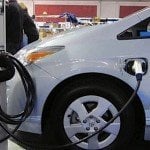The use of natural gas, solar panels and wind turbines increased substantially in the United States in 2012, while use of coal, oil and nuclear power dropped. The increased use in renewable energy sources is described in a report from the Lawrence Livermore National Laboratory (LLNL). Overall, renewables provided 49 per cent of all new power generation capacity in the US.
The greater use of renewables confirms that the United States is in step with the rest of the world: the International Energy Agency reported last month that renewables are the fastest growing sector for power generation, and projected that they would surpass gas and nuclear by 2016. By the year 2018, renewables could account for 25 per cent of the world’s energy.

The highest percentage gains were in wind power. Backed by US government incentives, new wind farms came on-stream with bigger, more efficient turbines, increasing their electricity output from 1.17 quadrillion BTU (quads) in 2011 to 1.36 quads in 2012. This represents about 3.5 per cent of the total electricity generated.
There are currently 45,000 wind turbines operating in the US, generating enough power for 15 million homes. The American Wind Energy Association (AWEA) says that the annual investment in wind in 2012 was $25 billion.
Solar power also rose, from 0.158 quads to 0.235 quads in 2012. Most of that was in residential use, however, with only a small fraction going directly to electricity generation. Declining costs of photovoltaic panels was the main reason for the increase in solar adoption by consumers.
Nuclear power decreased for the first time in a decade, the LLNL report said, as four nuclear reactors went offline last year.
Petroleum remains the single largest component of the US energy mix, accounting for 34.7 quads, most of which goes to transportation and industrial use. Less than 1 per cent of petroleum was used to generate electricity.
Natural gas makes up the second largest component, with 26 quads of energy. Natural gas accounted for 24.4 per cent of power generation, the remainder going to home heating and industrial uses. This use of natural gas for electricity generation was up sharply, replacing coal as prices for natural gas have remained low. However, as prices for the two commodities fluctuate, their use tends to rise and fall.
Coal is, in fact, still a very important part of the energy picture, accounting for about 41 per cent of the electricity generated in the US in 2012. Consumption of coal was up 11 per cent in the first quarter of 2013, the US Department of Energy reported today, though the increased consumption was based on existing stockpiles rather than new purchases of stocks.





























